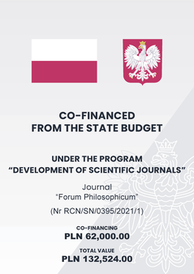- Home »
- Issues »
- 14/1 - Spring 2009 »
- Articles »
The Interplay of Philosophy and Religion in the Chinese Culture
Abstract
The aim of this article is to present the interplay between philosophy, religion and culture in China, to give a clear picture of philosophical, religious and cultural aspects of Chinese culture. What do we understand by Chinese culture? What is the role of Religion and Philosophy in Chinese Culture? The goal of this presentation is to present a deeper account of the philosophical, cultural and traditional differences and similarities between the Chinese and the Western World. What is the meaning of Chinese philosophical ideas? How do we understand and interpret Chinese thought? How do we build a bridge between East and West focused on cultural, philosophical and religious aspects? What has the West done for China and what has China done for West? Are we partners in inter-religious, cultural and philosophical dialogue?
Keywords
Cite this article
Konior, Jan. “The Interplay of Philosophy and Religion in the Chinese Culture.” Forum Philosophicum 14, no. 1 (2009): 57–67. doi:10.35765/forphil.2009.1401.04.
Bibliography
Aristotle. Nicomachean Ethics. Translated by Harris Rackham Harvard University Press, 1934. Benedict XVI. “Chrześcijaństwo ma być zachętą do prawdy.” Wiadomości KAI 4, 27 January 2008. Benedict XVI. “List Ojca Świętego Benedykta XVI do Biskupów, do kapłanów, do osób konsekrowanych oraz do Wiernych Świeckich Kościoła katolickiego w Chińskiej Republice Ludowej.” La Santa Sede. Accessed January 1, 2009. http://w2.vatican.va/content/benedict-xvi/pl/letters/2007/documents/hf_ben-xvi_let_20070527_china.html. Benedict XVI. “Ansprache von Benedict XVI. An die Bischöfe von Taiwan anlässlich ihres ‘Ad-Limina’—Besuch.” China Heute 28, no. 1 (2009): 25–29. Cronin, Vincent. The Wise Man from the West. Matteo Ricci and his Mission to China. New York: Dutton, 1955. Cua, Atnonio S. “Identity of Chinese Philosophy and its Modern Studies. Emergence of the History of Chinese Philosophy.” In Comparative Approaches to Chinese Philosophy, edited by Bo Mou. Burlington, VT: Ashgate, 2006. Ebrey, Patricia Buckley, ed. Chinese Civilization and Society: A Sourcebook. New York: The Free Press, 1981. Granet, Marcel. Cywilizacja Chinska. Translated by Mieczysław J. Künstler. Warszawa: Państwowy Instytut Wydawniczy, 1973. Ko, Ha Fong Maria. “Ways to Christian Identity.” In Papers and Materials of the Third European Catholic China Colloquium. The Catholic Church in China: Message, Response and Commitment, (Poland Krynica Morska, 15–18 September 1999), edited by Roman Malek, Katharina Feith, 116–121. European Ecumenical China Communication, no. 5. China–Zentrum: Sankt Augustin 2003. Kowalski, Krzysztof. “Praczłowiek za Wielkim Murem.” Rzeczpospolita, January 24, 2008. http://www.rp.pl/artykul/86639.html. Kozakiewicz, Beata. “Wielki Mur Chiński.” Królowa Apostołów – Miejsca Święte, 2002: 27–28. Künstler, Mieczysław Jerzy. Języki chińskie. Warszawa: Dialog, 2000. Liu, JeeLoo. An Introduction to Chinese Philosophy: From Ancient Philosophy to Chinese Buddhism. Malden, MA: Blackwell, 2006. Olszewski, Wiesław. Chiny: zarys kultury. Poznań: Wydawnictwo Naukowe Uniwersytetu im. Adama Mickiewicza, 2003. Rodziński, Witold. Historia Chin. Wrocław: Ossolineum, 1992. Uhlig, Helmut. Jedwabny szlak: kultury antyku między Chinami a Rzymem. Translated by Janusz Danecki. Warszawa: Państwowy Instytut Wydawniczy, 1996. Wu, John Ching-Hsiung. O radości. Translated and introduced by Roman Malek. Warszawa: Verbinum, 1987.




